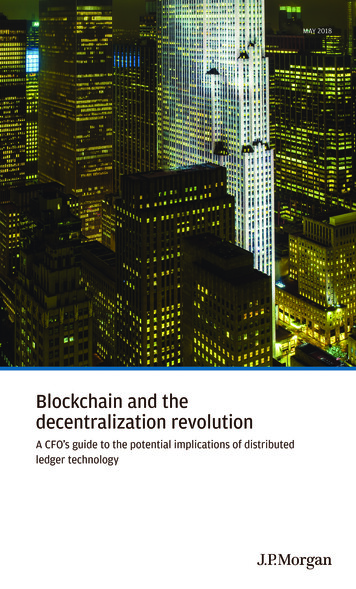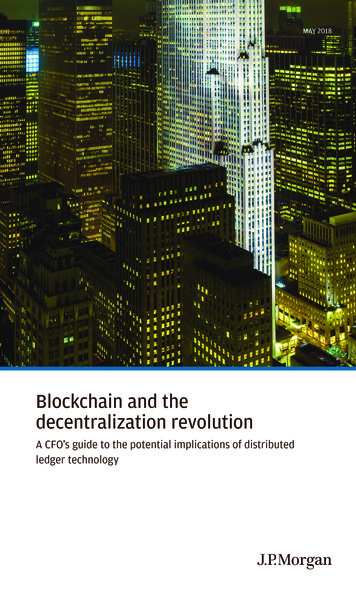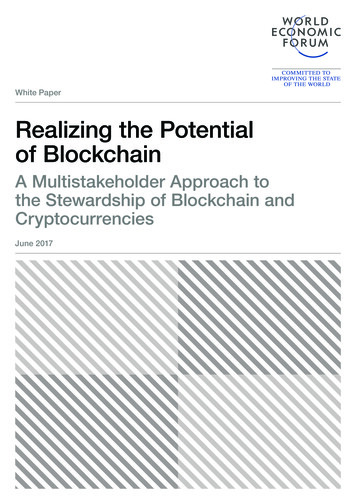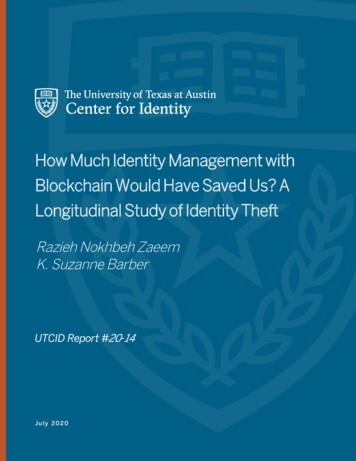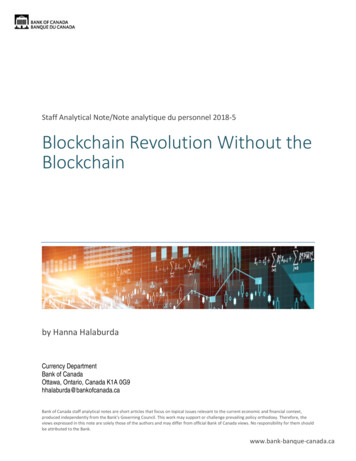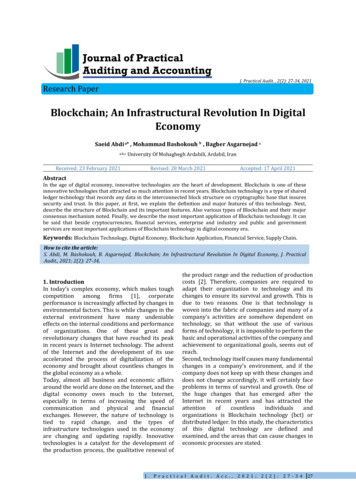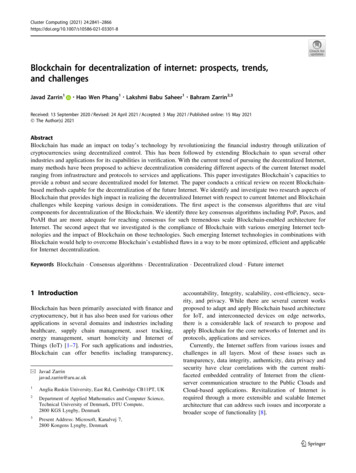
Transcription
Cluster Computing (2021) 3301-8(0123456789().,-volV)(0123456789().,- volV)Blockchain for decentralization of internet: prospects, trends,and challengesJavad Zarrin1 Hao Wen Phang1 Lakshmi Babu Saheer1 Bahram Zarrin2,3Received: 13 September 2020 / Revised: 24 April 2021 / Accepted: 3 May 2021 / Published online: 15 May 2021Ó The Author(s) 2021AbstractBlockchain has made an impact on today’s technology by revolutionizing the financial industry through utilization ofcryptocurrencies using decentralized control. This has been followed by extending Blockchain to span several otherindustries and applications for its capabilities in verification. With the current trend of pursuing the decentralized Internet,many methods have been proposed to achieve decentralization considering different aspects of the current Internet modelranging from infrastructure and protocols to services and applications. This paper investigates Blockchain’s capacities toprovide a robust and secure decentralized model for Internet. The paper conducts a critical review on recent Blockchainbased methods capable for the decentralization of the future Internet. We identify and investigate two research aspects ofBlockchain that provides high impact in realizing the decentralized Internet with respect to current Internet and Blockchainchallenges while keeping various design in considerations. The first aspect is the consensus algorithms that are vitalcomponents for decentralization of the Blockchain. We identify three key consensus algorithms including PoP, Paxos, andPoAH that are more adequate for reaching consensus for such tremendous scale Blockchain-enabled architecture forInternet. The second aspect that we investigated is the compliance of Blockchain with various emerging Internet technologies and the impact of Blockchain on those technologies. Such emerging Internet technologies in combinations withBlockchain would help to overcome Blockchain’s established flaws in a way to be more optimized, efficient and applicablefor Internet decentralization.Keywords Blockchain Consensus algorithms Decentralization Decentralized cloud Future internet1 IntroductionBlockchain has been primarily associated with finance andcryptocurrency, but it has also been used for various otherapplications in several domains and industries includinghealthcare, supply chain management, asset tracking,energy management, smart home/city and Internet ofThings (IoT) [1–7]. For such applications and industries,Blockchain can offer benefits including transparency,& Javad Zarrinjavad.zarrin@aru.ac.uk1Anglia Ruskin University, East Rd, Cambridge CB11PT, UK2Department of Applied Mathematics and Computer Science,Technical University of Denmark, DTU Compute,2800 KGS Lyngby, Denmark3Present Address: Microsoft, Kanalvej 7,2800 Kongens Lyngby, Denmarkaccountability, Integrity, scalability, cost-efficiency, security, and privacy. While there are several current worksproposed to adapt and apply Blockchain based architecturefor IoT, and interconnected devices on edge networks,there is a considerable lack of research to propose andapply Blockchain for the core networks of Internet and itsprotocols, applications and services.Currently, the Internet suffers from various issues andchallenges in all layers. Most of these issues such astransparency, data integrity, authenticity, data privacy andsecurity have clear correlations with the current multifaceted embedded centrality of Internet from the clientserver communication structure to the Public Clouds andCloud-based applications. Revitalization of Internet isrequired through a more extensible and scalable Internetarchitecture that can address such issues and incorporate abroader scope of functionality [8].123
2842In the prospect of finding ways to further improve theexisting Internet model, there are two major approachesbeing spearheaded for the development of future Internet:Semantic Web and Decentralized Internet, the formersuggests to connect every piece of information entity viaSemantic technology in a way to be united into a singularity [9]. The second generation of Web technology(Web2) introduced online services that brought in flaws ofrequiring centralized services, which is seen in client-server model. Semantic Web (Web3) aimed to extend Web2using a data-driven model enabling integration acrossheterogeneous content, applications and systems throughunderstanding data in machine-level. Semantic Web isprogressing through heavily relying on machine learningand artificial intelligence (AI) methods to create moresmart content and open Web applications for future Internet. However, the scope and the impact of Semantic Web islimited into application layer and it cant be relied as acomplete solution to resolve some inherent Internet issueswhich have roots in centralized nature of current Internet.The alternate approach is to decentralize and disseminate the Internet in all layers for equal role and authoritypower to prevent monopolization from online services [10].Some decentralization approaches have already proposedin current literature to resolve Internet flaws originatedfrom centralization [11–13]. Also, in recent years, thepopularity of decentralization has been further glorified inBlockchain due to its success in decentralization forcryptocurrencies [10].The centralization of the Internet is not accomplishedfrom a single night, but the gradual development of theInternet and its services over the years. The introduction ofcentralized services provided convenience and acceleratedthe maturity of the Internet. This acceleration from centralization made it widely dependent throughout theInternet. Although these centralized services have providednumerous advancements that have made up the currentInternet, the bottom line is that a centralized service wouldstill exhibit a centralized network’s vulnerabilities thatwould jeopardize the network. By having users relying on acentralized service, the users are opened to various types ofattacks like Distributed Denial-of-service (DDoS) thatcould have been easily mitigated through decentralization.The main motivation for this work came from theacknowledgment of reliance on centralized systems withinthe Internet [14]. It is clear that according to [15] there hasbeen a push for the development of the Internet to beconsolidated into a central overseeing figure for administration. This matter of consolidation with information datais further provoked by privacy concerns caused by largeorganizations as part of the Big Data scheme.Combating this centralization is achievable throughdecentralization with Blockchain. Blockchain has always123Cluster Computing (2021) 24:2841–2866been classified as a disruptive technology due to its impactfor providing a decentralized solution for communicationand transaction. This brings us to Blockchain’s consensusalgorithms being capable of enforcing equal roles betweenpeers. This enforcement would also keep these onlineservices in check, preventing centralized power. Theaspiration to obtain decentralization is broadened with thetrend of implementing Blockchain into Internet Of Things(IoT), and to account for scaling to support the Big Data ofthe future Internet.The Internet is a tremendously scaled, geographicallydistributed, global system of interconnected computernetworks that uses the Internet protocol suite (TCP/IP) forcommunications across nodes and networks. It comprisesvarious components, including infrastructures, hosts,devices, protocols, operating systems, services, andapplications.Throughout this paper, we frequently use the terms‘‘decentralized Internet’’ and ‘‘Internet decentralization’’ torepresent the concept of applying possible decentralizedapproaches in various levels and into any Internet components (e.g., decentralized protocols, applications, andinfrastructure) in general and particularly for Web (socalled Decentralized Web, dWeb or Web 3.0). The originalWeb 1.0 introduced communication with HypertextTransfer Protocol (HTTP) and established static web pagesas content on the Web. Web 2.0 allowed users to collaborate and utilize server-side scripting to allow online services to proliferate. It is due to the growth of onlineservices that led to the conceptualization of Web 3.0 beingdecentralized. Web 3.0 has been around as a concept sincethe early 2010s. The concept of Web 3.0 centers arounduser autonomy and not being reliant on centralized services, essentially having users be responsible for their data.The three generations of the Web can be seen in Fig. 1.Current Internet model and architecture suffers from alarge number of issues due to the impact of centralization.These issues include:Scalability and availability Internet resources andservices (e.g., computing, storage, network, and databaseresources ranged from single servers to large scale Cloudbased server-farms/datacenters) have limited capacity andcannot cope with the requirements of the increasing number of users without their direct contributions in providingresources. Large Internet companies may fail to provideresources to users in different geographical regions or overa specific time. This raises another issue, which is theavailability of resources. In 2019, Microsoft Azure wasreportedly running out of VMs for its customers in EastU.S. [16]. Similarly, in March 2020, Azure has sufferedfrom a shortage in data center capacity due to a largeamount of demands resulted by Covid-19 pandemic [17].
Cluster Computing (2021) 24:2841–28662843Fig. 1 Generations of webtechnologyWeb 3.0Web 2.0OwningContentWebFormsPageViewsWeb formation FlowXML/RSSRead and WriteSharingContentHTML/PortalsRead liability Services based on the client-server modelare vulnerable to a single point of failure and bottleneck.They may fail to provide services due to problems likenetwork or system failure.Security and privacy Collecting user data by differentservice providers and storing them in a certain number ofspecific servers to support the hosting of various types ofservices and applications expose vulnerabilities and userdata privacy to cybercriminals.Trustability Large Internet corporations and serviceproviders are trusted parties that can potentially maintain,control, and administrate user data, access, and activities.While this can bring benefits for the users, it potentially canbe used as a source of control to apply surveillance orcensorship, or it can lead to abusing trustability [18]. Inthis paper, we provide a systematic review of the potentialsand capabilities of Blockchain-based solutions which canefficiently be used for any aspect of the Internet decentralization. There are several other approaches for decentralizing the Internet, such as projects seen in Sect. 2.3.However, our focus in this paper centers around usingBlockchain to decentralize the Internet. Also, it must betaken into account that Blockchain for IoT security is out ofthe scope of this paper due to space limitations.In this paper, we consider the popularity of Blockchainfor decentralization and the aforementioned Internet issuesand provide the following contributions: (a) We identifythat the current Internet is highly centralized, and wereview challenges of centralized Internet and methods forInternet decentralisation. (b) We provide a detailed reviewon opportunities and challenges to use Blockchain as a keyenabler for decentralization of Internet. (c) We explore andassess various Blockchain components, methods, techniques and algorithms with respect to the Internet openissues and provide a detailed review on Blockchainpotentials to resolve the problem on centralization in current Internet. (d) We also provide a review on otheremerging Internet relevant technologies to identify howBehaviouralAdvertisingPortableand PersonalisedBi-DirectionalInformation FlowTaggingSemanticWebRDF/RDFS/OWLUser Engagementand nd WikipediaSmartApplicationsthey can be combined with Blockchain, covering itsdrawbacks to create a better solution for future Internet.The rest of this paper organized as follows: Sect. 2provides an overview of the current Internet architectureand what Blockchain is facing against, Sect. 3 revolvesaround understanding Blockchain’s components and challenges it would face on decentralization, Sect. 4 presents alist of consensus algorithms that have the potential to be acandidate for reaching consensus within the Internet, Sect.5 discusses the emergence of future and old technologiesthat can be integrated with Blockchain, Sect. 6 presents adiscussion of current and future technologies that canimpact and benefit Blockchain in decentralizing the Internet, and finally Sect. 8 concludes the paper and discussesfuture works.2 Understanding the contemporary internetarchitectureThe Internet architecture has amassed to a tremendousscale where it encompasses many systems, services, protocols, architecture, and hardware to use on such anextensive scale. It is nearly impossible to cover everyintricacy of the Internet. However, instead, this sectionmainly considers the macro-scale of the Internet’s modeland generally discusses why it is centralized and challengescaused by current centralized Internet architecture Thissection is followed by summarizing the types of decentralization that can be achieved with the Internet. Only tofinish on why Blockchain is the choice for decentralizingthe Internet.2.1 Current internet is centralizedThe current Internet is centralized due to the unusualarchitecture that has been designed to route users to passthrough a singular point before the users can interact on the123
2844Internet. This singular point on the Web can be seen inmany forms, such as Domain Name System (DNS), whereit acts as a translator for IP addresses and Domain namesfor human and computer readability. The DNS wasimplemented in a distributed way in Web 2.0, but traces ofcentralization are observed in domain name servers,namespace governance and operation [13, 19]. This centralization is further supported by the monopolization ofDNS generation and distribution on the web by the InternetCorporation for Assigned Names and Numbers (ICANN)[12]. Internet Service Providers (ISP) are another centralized point, as users need to establish a connection with anISP before the user can interact with the Internet. Thisallows ISPs to have control over the Internet traffic andallow third-party organizations to have access and controlInternet traffic flow. The fact that the Internet is heavilydependent on DNS and ISPs to operate, proves our reasoning of centralization that occur within the Internetarchitecture.2.2 Challenges of centralized internetThe Transmission Control Protocol/Internet Protocol (TCP/IP) is synonymous with the Internet when discussing howthe Internet communicates [20]; this brings up the questionof decentralization compatibility. Considering the fact thatTCP/IP has been the catalyst for the Internet since the verybeginning, most improvements to the Internet appear to berevolved around TCP/IP. In the continuation of this section, we discuss the issues related to each OSI layer as wellas the infrastructure issues.2.2.1 Application layerThe Application layer is the standardizing layer to enforceand conform applications, such as web-browsers and webservers to allow end-users to communicate between eachother through the Internet. HTTP and its secure successorHypertext Transfer Protocol Secure (HTTPS) are wellknown examples of protocols placed on the applicationlayer. These protocols are fundamental to the Web, and isimplemented all over the Internet with reliance on theclient-server networking model (a centralized architecture).Blockchain can be considered an alternate solution ofcommunication to decentralize HTTPS. However, Blockchain is an entirely different system that communicatesusing its own standards and protocols, meaning that acommunication method between HTTPS and Blockchainneeds to be established. Furthermore, Blockchain employscompletely different security measures compared toHTTPS. This difference in security lies in HTTPS using amulti handshake protocol [21], while Blockchain uses across-referencing method.123Cluster Computing (2021) 24:2841–2866The DNS is an application layer service which is used toresolve names to addresses or vice versa. It is a vital protocol within the Internet model that translates unique IPaddresses to human-readable addresses [22]. Security is anessential aspect in DNS, and methods of providing securitysuch as extensions like Domain Name System SecurityExtensions (DNSSec) are used [23] to mitigate againstDDoS, configuration tampering, DNS poisoning, andinformation leakage as well as countless other DNS vulnerabilities [23]. The DNS in the current Web 2.0 is centralized as discussed in Sect. 2.1; this brings up thequestion of how can we decentralize DNS while maintaining the same functionality of translation. The solutionto that centralization is a decentralized name system. Thedecentralization of the naming system can be seen withnumerous proposals, where each employs Blockchain andPeer-to-Peer (P2P) technology to achieve decentralization.SocialDNS [19] employs short-names for resources in alocalized area network while using a rank-based mechanism to handle name conflicts. SocialDNS uses P2P toenable virtual organization of the domain names, withoutthe need of a central authority. BlockDNS [13] is anothersolution for decentralizing the name system, as it allowsusers to apply domain names while maintaining authoritative server information in a decentralized way.BlockDNS employs the use of a lightweight verificationsystem that can cut the overhead of data authenticity verification to a few hundred bytes, allowing the BlockDNS tohandle more DNS queries in the DNS cache. ConsortiumDNS [12] is another DNS to consider. It resolves thelimitation of storage in a blockchain by using a three-layerarchitecture with external storage. This design in ConsortiumDNS allows indexing of transactions and Blockchainblocks for increased performance of domain name resolution. Last of the proposal is Bitforest, which uses a partiallytrusted centralized name server in a Blockchain withcryptocurrency to achieve decentralized trust and security.Bitforest [24] is capable of the same performance andscalability of centralized Public Key Infrastructures (PKI)in client validation and verification of name bindings.Bitforest’s architecture maintains decentralization by notallowing the administrator to violate identity retention.2.2.2 Transport layerThe transport layer encompasses communication protocolsto provide end-to-end communication services such asreliability, traffic, and flow control to applications runningon hosts [20]. Its services has been the same since earlydays of the Internet, which is to offer a connection betweenhosts. Over the years, flaws and limitations have beenuncovered for the transport layer, from enumeration attacksfor extracting information about the targeted system and
Cluster Computing (2021) 24:2841–2866network, using fingerprinting techniques to uncover openports of a system for infiltration, to SYN flood attacks tooverwhelm a system. Due to this uncertainty of securitycreated from the flaws in the transport layer, an alternativesecurity solution should be sought. There are two optionsthat can resolve the problems presented in the transportlayer. The first option revolves around [25] by greenfielding and implement a policy-based security module intoTCP/IP. This greenfield option would use four-way handshaking and public-key cryptography to ensure a secureentity that would maintain and monitor the security in thesystem. The second option would be to follow [26] andbrownfield it by transitioning TCP/IP into Named DataNetwork (NDN). NDN is the contending winner, as it isrobust enough to offer enhanced performance for the network traffic. More of NDN will be discussed on the Sect. 5.2.2.3 Network layerThe network layer is one of the major backbones withmany inner mechanisms working in conjunction with thislayer within the Internet architecture. This layer allowscommunication protocols such as IP for the delivery ofpackets since IP as by itself does not guarantee the deliveryof the packets to the intended destinations. The networklayer cooperates with the transport layer to deliver thepackets via TCP, guaranteeing the arrival of packets on thedestination node. Hosts on the Internet use names (i.e.,domain names for the servers) or numbers (IP addresses forboth servers and clients) or both of them together tocommunicate across the Internet. Client hosts need toresolve server names to IP addresses before being able toinitiate requests for communications.Internet Protocol Version 4 (IPv4) has an issue ofaddress space limitation where it is not able to accommodate future IP addresses due to exhaustion of usableaddresses [27–29]. Internet Protocol Version 6 (IPv6) hasalways been regarded as a successor towards IPv4. IPv6 isable to solve the issue of address space limitation in IPv4by increasing the size from 32 to 128 bits [27] and alsosolving many of the limitations and security issues withinIPv4. Having a full transition from existing IPv4 addressesto IPv6 address is near impossible due to the high cost ofreplacing existing IPv4 Internet infrastructures e.g., IPv4routers. One important aspect within the arsenal of IPv6 isthe ability of ‘‘tunneling’’ between IPv4 and IPv6. Tunneling allows IPv6 to encapsulate itself into an IPv4address and cross-communicate with the existing IPv4addresses [30]. The tunneling feature would be an essentialcomponent in the implementation of Blockchain for theInternet, as the Blockchain’s domain consists of multipleinteroperable smart contracts. Without this tunneling feature, nodes would only be able to communicate with IP2845versions that is supported. Not being able to communicatewith other versions of IP would result in blocking off theother half of the Internet to communicate with. As of June27th 2020, Google has collected statistics across the Weband have shown that 67.08% of the web is still in IPv4,while the remaining 32.92% has migrated to IPv6 [31].2.2.4 Data-link layerLastly, the data-link layer in the TCP/IP model consists ofOSI’s data-link layer and a physical layer. The physicalpart of this layer establishes the hardware needed forinterchangeability and interconnection of the network linkbetween hosts, routers, and switches. The software usesprotocols to encapsulate packets received from the networklayer into other frames with Media Access Control (MAC)address and prepares it for transmission. The data-linklayer also provides synchronization and validation for theframes, as it transfers receiving packets with the corresponding and correct MAC address to the network layer.The service that this layer uses consists of WLAN, LAN,Ethernet, and other similar network devices to overcomethe limitations of the network layer [32].The TCP/IP model may also include the 5th physicallayer which encompasses the hardware needed for sustaining the network [20, 33]. This physical layer can beseen as a segregation of the data-link layer to establishclarity between hardware and software. However, thishardware layer could be prominent in the future with IoT,as computers are increasingly prevalent in terms ofeveryday usage over time.2.2.5 Internet infrastructureAs illustrated in Fig. 2, a centralized point is seen witheach respective ISP. Users are provided access to theInternet through centrally administrated entities, which areso-called ISP networks. We understand that ISP plays theman-in-the-middle for computers to communicate with theInternet, which resulted in this centralized Internet trafficroute. A centralized infrastructure is always ideal in aprivate network for allowing a governing entity to easilyadministrate and have an overview of the network and itsconnections. There is also the case of fault tolerance systems where it accounts for preventing disruption on thenetwork from a single component failure that has experienced prolonged continuity of operation. This allows forthe lowered costs for IT equipment, expenditures, andmaintenance. But this lowered cost would enable thearchitecture to have a decreased level of maintainabilityand accommodate more expansion [35].Single point of failure is a major flaw in a centralizednetwork, as it is caused by the need to trust a central entity123
2846Cluster Computing (2021) 24:2841–2866Fig. 2 The internet architecture[34]GlobalISPRoot DNS ServersInternet/CoreNetworkIoTEdgeNetwork NetworkNetworkAccess tropolitanArea Exchange(MAE)Other GlobalRegional PNetworkTechnologyTCP/UDP Traffic[36]. This singular point of failure can also be reflected as asingular point of control, where the central system can havetotal control of the network and its participating nodes dueto its converging point of contact. Security risks areanother flaw, due to the possibility of compromised entrypoints into the infrastructure. These entry points wouldensure a major risk for both the network and the databases.The second major flaw is caused due to the exponentialgrowth of information data on the Internet. This exponential growth would cascade into the need for expandedcapacity for data storage [37] to respond against theincreasing information data. This need for increased storage data ties heavily to Big Data with extensive information data needing to be stored, resulting in a scalabilityissue. The scalability issues mainly come from usinglegacy databases that lack the efficiency and performanceto respond to the ever-increasing information data needingto be stored across various devices on the Internet. Tocounteract this, implementing IoT into the Blockchainwould allow it to cope against scalability issues bydesigning a new consensus algorithm that increases thethroughput to handle the large information data, or locatesthe databases in a private or consortium Blockchain whereit can process the database at a much higher speed[38]. Thecurrent security with Alt-Svc that was introduced for HTTP[39] has many underlying vulnerabilities such as bypassingblack-listed sites, distributed port-scanning and DDoS ofnon-HTTP sites. This makes Alt-Svc highly abusable formalicious purposes, and would be a critical issue.2.3 Types of decentralizationThe original network design of the Web with HTTP by TimBerners-Lee was envisioned to be a decentralized infrastructure [40]. However, throughout its lifespan, as stated by[10], the Internet has developed into a centralized infrastructure. The decentralized network option has been123IPv4IPv6TCP/UDP Trafficgaining traction, as the idea emphasizes on developing newprotocols and underlying technologies through Peer-to-peer(P2P) technology for a shared data layer within the architecture [10]. A decentralized Internet would be able to giveresiliency for data security, which would offer incentivesfor users to cooperate and further expand [37, 38]. Thiswould increase scalability to support complex transactionsof information data. Examples of decentralized Internet canbe seen on projects like The Onion Route (TOR), Zeronet,and The Invisible Internet Project (I2P) [41–43]. The goalof these projects is to allow users to surf the Internetanonymously anywhere on the Internet while reducingtheir footprints.Based on our current research, there are currently twotypes of decentralized networks that can achieve the idealdecentralized Internet.The first method involves a completely decentralizednetwork by [36] where ‘‘trust’’ and controls are spreadacross anonymous users. These ‘‘trust’’ ensures controls arefrom each individual users and not from a centralizedpoint. But one drawback with this method, is that itrequires the need of standardization for network systems.This would come as a possible challenge due to thedivergence of operating systems and how networks arebeing configured in the proceeding future. Additionally,utilizing a fully decentralized network comes with the riskof losing the conveniences provided by Internet servicesthat have been developed with centralization technology inWeb 2.0.The other type of decentralization method is utilizing adistributed network. The distributed network ensures thatevery participating computer is inter-connected and is codependent with each other. This inter-connectivity betweencomputers would allow legacy centralized systems to runwithin the network in a pseudo-decentralized way. Tocompletely transform the current Internet to be completelydecentralized and autonomous would be near impossible
Cluster Computing (2021) 24:2841–28662847with its current expansion rate of network. But this methodof distributed network would be efficient in convertingexisting webs to be decentralized and allow legacy centralized networks to exists in a decentralized manner.2.4 Blockchain for decentralizationBlockchain allows the Internet to achieve a distributed stateof the network by allowing ‘‘trust’’ to be shared across theconnecting networks. This ‘‘trust’’ gives the notion of webof trusts between nodes in the Blockchain. Furthermore,Blockchain has ties to the mentioned decentralized Internetprojects in Sect. 2.3. Those projects have some peculiartraits, whereby P2P, data storage, and encryption play anessential role in each project. Blockchain also parallelsthese traits; therefore, we consider it as the most prominentoption for Internet decentralization throughout this paper.The way Blockchain is able to accomplish these features isdue to its components that are shown in Fig. 3, which willbe
components for decentralization of the Blockchain. We identify three key consensus algorithms including PoP, Paxos, and PoAH that are more adequate for reaching consensus for such tremendous scale Blockchain-enabled architecture for Internet. The second aspect that we investigated is the compliance of Blockchain with various emerging Internet tech-
